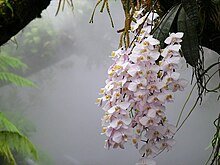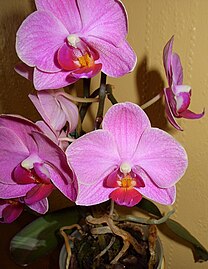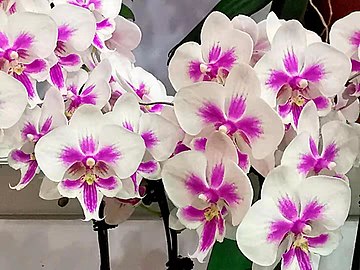| Phalaenopsis | |
|---|---|

| |
| Phalaenopsis philippinensis | |
| Scientific classification | |
| Kingdom: | Plantae |
| Clade: | Tracheophytes |
| Clade: | Angiosperms |
| Clade: | Monocots |
| Order: | Asparagales |
| Family: | Orchidaceae |
| Subfamily: | Epidendroideae |
| Tribe: | Vandeae |
| Subtribe: | Aeridinae |
| Genus: | Phalaenopsis Blume |
| Type species | |
| Phalaenopsis amabilis Blume (1825) | |
| Species | |
|
About 70; see List of Phalaenopsis species | |
| Synonyms | |
| |
Phalaenopsis (/ˌfælɪˈnɒpsɪs/), also known as moth orchids, is a genus of about seventy species of plants in the family Orchidaceae. Orchids in this genus are monopodial epiphytes or lithophytes with long, coarse roots, short, leafy stems and long-lasting, flat flowers arranged in a flowering stem that often branches near the end. Orchids in this genus are native to Asia, New Guinea, and Australia, but mostly occur in Indonesia and the Philippines.
Description






Orchids in the genus Phalaenopsis are monopodial epiphytic, sometimes lithophytic herbs with long, coarse roots with pneumatodes (which allow for gaseous exchange of the photosynthetic roots), and short leafy stems hidden by overlapping leaf bases. The leaves are usually arranged in two rows, relatively large and leathery, oblong to elliptic and sometimes succulent. A few to many, small to large, long-lasting, flat, often fragrant flowers are arranged on erect to hanging racemes or panicles. The sepals and petals are free from and spread widely apart from each other. The lateral sepals are usually larger than the dorsal sepal and the petals much wider than the sepals. The labellum is joined stiffly to the column and has three lobes. The side lobes are erect and more or less parallel to each other and the middle lobe sometimes has a pair of appendages or antennae.
Reproduction
Unlike most other angiosperms, the development of the ovules is triggered by pollination. Therefore a temporal mismatch of male and female gametes exists (i.e. the male structures are ready but the female structures have not yet been fully developed). In orchids, fertilisation occurs within days or months after the pollination event. After pollination occurs, the stigmatic cavity is often closed through swelling of the column. As a result, the pollinia are completely enclosed. The pollen germinates after enclosure and tubes are produced. In Phalaenopsis aphrodite, pollen tubes entered the ovary within 3 days after pollination. Within 15 days, pollen tubes evenly spread throughout the placental cavities. Within 60 days after the pollination event, 30.6% of the tips of the pollen tubes started to enter the micropyles (i.e. entry points) of the ovules. Finally, 65 to 70 days after the pollination event, fertilisation occurred.
Phalaenopsis are unique in that in some species of the subgenus Polychilos, the flowers turn into green leaves after pollination. As in many other plants, the petals of the orchid flowers serve to attract pollinating insects and protect essential organs. Following pollination, petals usually will undergo senescence (i.e. wilt and disintegrate) because it is metabolically expensive to maintain them. However, in many Phalaenopsis species, such as P. violacea, the petals and sepals find new uses following pollination, thus escaping programmed cell death. In producing chloroplasts, they turn green, become fleshy, and start to photosynthesize, as leaves do.
Phytochemistry
Floral fragrance has been analysed for several species. The fragrance of Phalaenopsis bellina has been shown to be composed of about 79 compounds, primarily of the terpenoid class. It was most intense in the morning.
In Phalaenopsis, phenylpropanoid enzymes are enhanced in the process of plant acclimatisation at different levels of photosynthetic photon flux.
Taxonomy
The genus Phalaenopsis was first formally described in 1825 by Carl Ludwig Blume and the description was published in Bijdragen tot de flora van Nederlandsch Indië. The name Phalaenopsis is derived from the Ancient Greek word φαλαινα (phalaina) meaning 'a kind of moth' with the suffix -opsis meaning 'having the appearance of' or 'like'.
The genus name is abbreviated Phal. horticulturally.
Infrageneric structure
The large monophyletic genus Phalaenopsis is divided into several sub-units. They are either regarded as subgenera or as sections. Not all of them are monophyletic.
The subgenus Polychilos is monophyletic and it is divided into two subclades. The subgenus Phalaenopsis is paraphyletic under its current definition. Likewise the evidence shows that the subgenera Aphyllae and Parishianae, as currently defined, are not monophyletic. The position of the monotypic subgenus Proboscidioides, which only consists of Phalaenopsis lowii, suggests a close relationship with the subgenus Aphyllae.
The following phylogenetic tree is a simplified tree to show the general placement of the main infrageneric groups. It is meant to give an overview, despite the contended monophyly of some of the respective groups.
| Phalaenopsis |
|
2 pollinia clade4 pollinia clade | |||||||||||||||||||||||||||||||||
Ornithochilus
Main article: Phalaenopsis subg. OrnithochilusThe former genus Ornithochilus was merged with Phalaenopsis and is considered by some to be a subgenus. Its members have distinctly 4-lobed, fringed labella with a short, curved spur situated near the middle of the lip as opposed to the base. Ornithochilus formerly had three known species, native to China, the Himalayas and Southeast Asia:
- Ornithochilus cacharensis Barbhuiya, B.K.Dutta & Schuit. - Assam
- Ornithochilus difformis (Wall. ex Lindl.) Schltr. - Guangdong, Guangxi, Sichuan, Yunnan, Assam, India, Bhutan, Nepal, Myanmar, Thailand, Vietnam, Laos, Borneo, Sumatra, Peninsular Malaysia
- Ornithochilus yingjiangensis Z.H.Tsi - Yunnan
Hygrochilus
Main article: Phalaenopsis subg. HygrochilusThe former genera Sedirea and Hygrochilus were incorporated into Phalaenopsis subgen. Hygrochilus. The interspecific relationships within the subgenus Hygrochilus are poorly understood and are a source of confusion. The type species of the subgenus is Phalaenopsis hygrochila. The species of this subgenus are morphologically distinct from the other subgenera, due to their four pollinia and spurred flowers, as well as their unusually long stems.
Species list
See List of Phalaenopsis species
Intergeneric hybrids
See List of Phalaenopsis species
Distribution
Species of Phalaenopsis are found from India to southern China, Indochina, Malaysia and from Indonesia to the Philippines and New Guinea. There is a single species, Phalaenopsis rosenstromii, endemic to Queensland, Australia. Phalaenopsis stuartiana has become naturalised in Costa Rica, Panama, and Suriname.
Ecology
Pollination of Phalaenopsis pulcherrima through bees, specifically Amegilla nigritar, has been recorded in China. This species employs a deceptive pollination strategy. The orchid does not provide rewards to pollinators. It benefits from blooming in the same period as rewarding species. Amegilla is the most important pollinator, but diurnal insects – such as four species of bees, two species of butterflies, one species of moth and two other unidentified insects – have also been observed to interact with the flowers.
Conservation
Many species are highly threatened. For instance Phalaenopsis lindenii is categorized as endangered, Phalaenopsis violacea is categorized as vulnerable and Phalaenopsis micholitzii is categorized as critically endangered. Some species, like P. javanica, are believed to be extinct in the wild.
Use in horticulture

Phalaenopsis, abbreviated Phal in the horticultural trade, are among the most popular orchids sold as potted plants, owing to the ease of propagation and flowering under artificial conditions. They were among the first tropical orchids in Victorian collections. Since the advent of the tetraploid hybrid Phalaenopsis Doris, they have become extremely easy to grow and flower in the home, as long as some care is taken to provide them with conditions that approximate their native habitats. Their commercial production has become an industry.
If very healthy, a Phalaenopsis plant may have up to ten or more leaves. They bloom in their full glory for several weeks. If kept in the home, the flowers may last two to three months after which a Phalaenopsis orchid will need to conserve energy for further leaf, bud, and root development.
In nature, Phalaenopsis species are typically fond of warm temperatures, thriving in temperatures around 20 to 35 °C (68–95 °F), but are adaptable to conditions more comfortable for human habitation in temperate zones (15 to 30 °C or 59–86 °F); at temperatures below 18 °C (64.4 °F) overwatering causes root rot and the plants will also drop their leaves if they experience temperatures below 60 °F for extended periods. Phalaenopsis prefer moderate humidity (60–70%) and low light of 12,000 to 20,000 lux. However, Phalaenopsis orchids can adapt to the lower humidity found in most homes. They are also typically hardier than other species of orchids, and this makes them particularly popular among first-time orchid growers.
The flower spikes appear from the pockets near the base of each leaf. The first sign is a light green "mitten-like" object that protrudes from the basal leaf tissue. Over approximately three months the spike elongates until it begins to swell fat buds that will bloom.
It previously was believed that flowering is triggered by a night-time drop in temperature of around 5 to 6 degrees over two to four consecutive weeks, usually in the fall, and a day-time drop in temperature to below 29 °C (84 °F). Using two Phalaenopsis clones, Matthew G. Blanchard and Erik S. Runkle (2006) established that, other culture conditions being optimal, flower initiation is controlled by daytime temperatures declining below 27 °C (81 °F), with a definite inhibition of flowering at temperatures exceeding 29 °C (84 °F). The long-held belief that reduced evening temperatures control flower initiation in Phalaenopsis was shown to be false. Rather, lower daytime temperatures influence flowering, while night time temperatures do not appear to have any effect.
Award of Garden Merit
In cultivation in the United Kingdom, the following have been awarded the Royal Horticultural Society's Award of Garden Merit:
- Brother Pico Sweetheart gx.
- Phalaenopsis amabilis
- Yellow Lightning gx.
References
- ^ ‹ The template below (WCSP) is being considered for deletion. See templates for discussion to help reach a consensus. ›
"Phalaenopsis". World Checklist of Selected Plant Families (WCSP). Royal Botanic Gardens, Kew.
- ^ Jones, David L. (2006). A complete guide to native orchids of Australia including the island territories. Frenchs Forest, N.S.W.: New Holland. p. 440. ISBN 978-1877069123.
- 李嘉慧, & 李哖. (1991). 台灣蝴蝶蘭根和葉的形態與解剖的特性. 中國園藝, 37(4), 237-248.
- Chomicki, Guillaume; Bidel, Luc P. R.; Ming, Feng; Coiro, Mario; Zhang, Xuan; Wang, Yaofeng; Baissac, Yves; Jay-Allemand, Christian; Renner, Susanne S. (2015). "The velamen protects photosynthetic orchid roots against UV-B damage, and a large dated phylogeny implies multiple gains and losses of this function during the Cenozoic". New Phytologist. 205 (3): 1330–1341. doi:10.1111/nph.13106. PMID 25345817.
- Chen, Xinqi; Wood, Jeffrey James. "Phalaenopsis". Flora of China. Retrieved 26 December 2018.
- Jones D.L.; et al. (2006). "Phalaenopsis". Australian Tropical Rainforest Orchids. Commonwealth Scientific and Industrial Research Organisation (CSIRO). Retrieved 6 March 2021.
- "Genus Phalaenopsis". Orchids of New Guinea. Retrieved 26 December 2018.
- Chen, Jhun-Chen; Fang, Su-Chiung (2016). "The long pollen tube journey and in vitro pollen germination of Phalaenopsis orchids". Plant Reproduction. 29 (1–2): 179–188. doi:10.1007/s00497-016-0280-z. PMC 4909812. PMID 27016359.
- Wouter G. van Doorn (October 2005). "Plant programmed cell death and the point of no return". Trends in Plant Science. 10 (10): 478–483. doi:10.1016/j.tplants.2005.08.003. PMID 16153879.
- Mus, Ahmad Asnawi; Gansau, Jualang Azlan; Kumar, Vijay Subbiah; Rusdi, Nor Azizun. "The variation of volatile compounds emitted from aromatic orchid ('Phalaenopsis bellina') at different timing and flowering stages". Plant Omics. 13 (2): 78–85.
- Ali, Mohammad Babar; Khatun, Serida; Hahn, Eun-Joo; Paek, Kee-Yoeup (2006). "Enhancement of phenylpropanoid enzymes and lignin in Phalaenopsis orchid and their influence on plant acclimatisation at different levels of photosynthetic photon flux". Plant Growth Regulation. 49 (2–3): 137–146. doi:10.1007/s10725-006-9003-z. S2CID 26821483.
- Blume, Carl Ludwig (1825). Bijdragen tot de flora van Nederlandsch Indië (Part 7). Batavia. p. 294. Retrieved 26 December 2018.
- ^ Brown, Roland Wilbur (1956). The Composition of Scientific Words. Washington, D.C.: Smithsonian Institution Press.
- Coombes, Allen J. (1994). Dictionary of Plant Names. London: Hamlyn Books. ISBN 978-0-600-58187-1. p. 140
- "Alphabetical list of standard abbreviations of all generic names occurring in current use in orchid hybrid registration as at 31st December 2007" (PDF). Royal Horticultural Society.
- Tsai, C. C.; Chiang, Y. C.; Huang, S. C.; Chen, C. H.; Chou, C. H. (2010). "Molecular phylogeny of Phalaenopsis Blume (Orchidaceae) on the basis of plastid and nuclear DNA". Plant Systematics and Evolution. 288 (1–2): 77–98. Bibcode:2010PSyEv.288...77T. doi:10.1007/s00606-010-0314-1. S2CID 29984034.
- Deng, HUA; Zhang, GUO-Qiang; Liu, Zhong-Jian; Wang, YAN (2015). "A new species and a new combination of Phalaenopsis (Orchidaceae: Epidendroideae: Aeridinae): Evidence from morphological and DNA analysis". Phytotaxa. 238 (3): 243. doi:10.11646/phytotaxa.238.3.3.
- ^ Li, Ming-HE; Gruss, Olaf; Liu, Zhong-Jian (2016). "Nomenclature changes in Phalaenopsis subgen. Hygrochilus (Orchidaceae; Epidendroideae; Vandeae) based on DNA evidence". Phytotaxa. 275: 55. doi:10.11646/phytotaxa.275.1.6.
- Tsai, C. C.; Chou, C. H. (2007). "Molecular phylogenetics of Phalaenopsis taxa: an updated review". Orchid Science and Biotechnology. 1 (2): 44–50.
- Tsai, C. C. (2003). Molecular phylogeny, biogeography, and evolutionary trends of the genus Phalaenopsis (Orchidaceae). PHD dissertation.
- Kew World Checklist of Selected Plant Families
- Flora of China v 25 p 448, 羽唇兰属 yu chun lan shu, Ornithochilus (Wallich ex Lindley) Bentham & J. D. Hooker, Gen. Pl. 3: 478, 581. 1883.
- "Factsheet - Phalaenopsis rosenstromii". www.anbg.gov.au. Retrieved 10 April 2022.
- Belfort-Oconitrillo, N., Salguero, G., Oses, L., Gil-Amaya, K., Rojas-Alvarado, G., Chinchilla, I. F., ... & Karremans, A. P. (2024). New species and records of Orchidaceae from Costa Rica. IV. Lankesteriana, 24(2), 141-192.
- Pramanik, Dewi; Dorst, Nemi; Meesters, Niels; Spaans, Marlies; Smets, Erik; Welten, Monique; Gravendeel, Barbara (2020). "Evolution and development of three highly specialized floral structures of bee-pollinated Phalaenopsis species". Evodevo. 11: 16. doi:10.1186/s13227-020-00160-z. PMC 7418404. PMID 32793330.
- Xiaohua, Jin; Dezhu, Li; Zongxin, Ren; Xiaoguo, Xiang (2012). "A generalized deceptive pollination system of Doritis pulcherrima (Aeridinae: Orchidaceae) with non-reconfigured pollinaria". BMC Plant Biology. 12: 67. doi:10.1186/1471-2229-12-67. PMC 3388949. PMID 22571550.
- "Phalaenopsis lindenii". International Union for Conservation of Nature and Natural Resources. Retrieved 4 March 2022.
- "Phalaenopsis violacea". International Union for Conservation of Nature and Natural Resources. Retrieved 4 March 2022.
- "Phalaenopsis micholitzii". International Union for Conservation of Nature and Natural Resources. Retrieved 4 March 2022.
- Garvita, R. V.; Handini, E. (2011). "Pengaruh penambahan berbagai kadar pisang dan ubi jalar pada pertumbuhan kultur tiga jenis phalaenopsis". Buletin Kebun Raya. 14 (2): 9–18.
- Adie, M. Muchlish; Krisnawati, Ayda (1970). "Identification of soybean genotypes adaptive and productive to acid soil agro-ecosystem". Biodiversitas Journal of Biological Diversity. 17 (2). doi:10.13057/biodiv/d170217.
- Stockton, Josh (20 January 2013). "Complete Care Guide to Phalaenopsis Orchid Care". Orchids Plus. Retrieved 19 September 2020.
- "How to Care for Orchids: A Comprehensive Organic Guide".
- Growing Conditions for Phalaenopsis Orchids, Accessed 11/11/2012 Archived 2013-01-14 at the Wayback Machine
- Blanchard, Matthew G; Runkle, Erik S (2006). "Temperature during the day, but not during the night, controls flowering of Phalaenopsis orchids". Journal of Experimental Botany. 57 (15): 4043–4050. doi:10.1093/jxb/erl176. PMID 17075080.
- "Phalaenopsis Brother Pico Sweetheart gx". RHS. Retrieved 18 January 2021.
- "Phalaenopsis amabilis". RHS. Retrieved 18 January 2021.
- "Phalaenopsis Yellow Lightning gx". RHS. Retrieved 18 January 2021.
- Seon Kim; Clifford W. Morden; Yoneo Sagawa & Jae -Young Kim (2003). "The Phylogeny of Phalaenopsis Species". Proceedings of NIOC2003, Nagoya, Japan.
- Olaf Gruss & Manfred Wolf - Phalaenopsis ; Edition Ulmer, ISBN 3-8001-6551-1 (in German)
- Eric A. Christenson - Phalaenopsis: a Monograph ; ISBN 0-88192-494-6
- Harper, Tom (February 2004). Phalaenopsis Culture: Advice for Growing 20 Species. Orchids Magazine 73 (2). Delray Beach, FL: American Orchid Society, 2004
- Leroy-Terquem, Gerald and Jean Parisot. 1991. Orchids: Care and Cultivation. London: Cassel Publishers Ltd.
- Schoser, Gustav. 1993. Orchid Growing Basics. New York: Sterling Publishing Co., Inc.
- White, Judy. 1996. Taylor’s Guide to Orchids. Frances Tenenbaum, Series Editor. New York: Houghton-Mifflin, ISBN 0395677262
External links
 Media related to Phalaenopsis at Wikimedia Commons
Media related to Phalaenopsis at Wikimedia Commons- Phalaenopsis orchids : species and primary hybrids
- Phalaenopsis orchid care instructions


